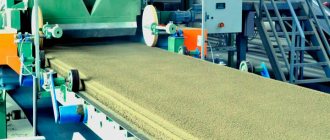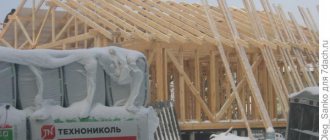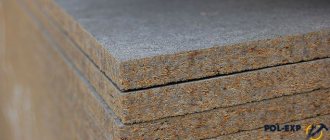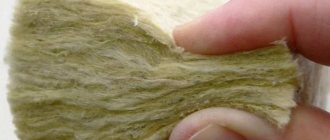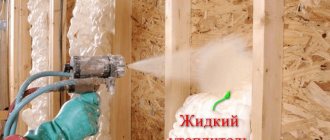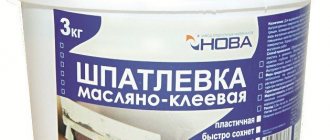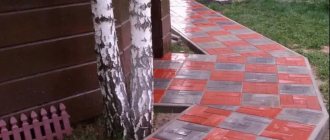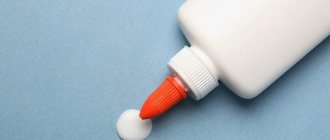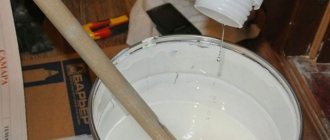What is OSB: composition, structure, production features and varieties
Externally, OSB boards are noticeably different from MDF and chipboard due to the structural features. In the production of the material, thin and long wood chips are used, which are oriented longitudinally in the outer layers, and transversely in the inner layers. Even in cases where the orientation is not very obvious, OSB can be recognized immediately by the large, compared to other wood-based panels, compressed elements. The length of the chips in the slab is 75-150 mm, and the width is 15-25 mm. Thanks to this orientation of the chips, the OSB board acquired properties that significantly expanded its scope of application.
The original name of the material is OSB (oriented strand board), which translated from English means “oriented strand board.” In Russia, both abbreviations are used - OSP and OSB. In some cases, you can also hear the abbreviation OSB, which is nothing more than a transliteration of the English abbreviation.
OSB is produced by pressing flat wood chips mixed with a binder material. For this purpose, special equipment is used, primarily modern high-tech pressing lines. Large factories in the USA and Europe use ContiRoll - continuous pressing lines.
The production process of OSB boards sequentially takes place in several stages:
1. Sorting of raw materials . The raw materials for the production of oriented strand board are timber from such tree species as aspen, spruce, pine and poplar. After the raw materials are delivered to the production line, the logs are carefully selected.
2. Preparation of raw materials and production of chips . After sorting, mechanized debarking of the logs takes place. Next, the cleaned logs are sawn into short pieces and sent to a planing unit, where they are split into chips along the wood fibers. At the end of the stage, the chips are dried using a conveyor and sorted.
3. Preparation of the composition for pressing and molding . Wax and adhesives based on paraffin, phenol-formaldehyde or isocyanate resin and boric acid are used as a binder for OSB boards, with which the chips are mixed in stages. The resulting mixture is then transferred to a molding station, where it is rolled out and molded into a uniform carpet before being sent to the press.
4. Pressing slabs . The board is pressed under a pressure of 5N/mm2 and at the temperature required for the resin to harden – 170-200 degrees. The temperature and pressure in the pressing zone are constantly monitored. After pressing and edge trimming, the material is subjected to control measurements of thickness and density, as well as checking for defects, and then aged for 48 hours until the final polymerization of the binders.
5. Slicing and packaging . After a quality control check, the OSB fabric is cut into elements of a standard format, the edges of the elements are profiled, and the resulting boards are sent to the marking and packaging line.
The main manufacturers of OSB boards are Canada, Austria, USA, and the Baltic states. OSB production lines were also opened in China, but due to the not very high quality of the boards, Chinese products did not become popular. In the period from 2012 to 2016, the production of oriented strand boards was launched in Russia, where, with the proper quality of the material, it was possible to achieve a lower cost.
Types of OSB boards
Depending on the quantitative and qualitative parameters, OSB boards are divided into 4 classes.
- OSB-1. Due to the lowest moisture resistance compared to slabs of other classes, it can be used exclusively in dry conditions in unloaded structures.
- OSB-2. The material is used for the construction of structures with load-bearing loads placed on them. For use only in dry conditions.
- OSB-3. The most common class of material in finishing and construction. Can withstand load-bearing loads and has an optimal price-functionality ratio. The technical characteristics of OSB-3 boards ensure the use of the material even in wet conditions.
- OSB-4 . These are the most durable and expensive materials. Increased reliability allows the material to be used in building structures with heavy loads in wet conditions.
In this case, the term “dry conditions” suggests that air humidity at a temperature of 20 0C may exceed the 65% threshold for only a few weeks a year. The term “humid conditions” suggests that air humidity at a temperature of 20 0C may exceed the 85% threshold for only a few weeks a year.
Danger of use in residential construction
The production technology of OSB boards involves the addition of binders with a pronounced odor. It does not erode for a long time. When covering walls, installing floors or ceilings, you should take into account that the smell will remain in the room for several weeks.
If you purchased material from a trusted manufacturer, it will disappear faster. If slabs of dubious quality were purchased, the smell may remain in the house for several months.
The problem described above may arise due to the selection of the wrong category of OSB panels. Products intended for outdoor use contain resins with a different chemical composition compared to boards used for work inside residential spaces.
The danger comes from formaldehyde fumes. All sheet building materials resulting from wood processing have this disadvantage. OSB panels contain less formaldehyde than particle boards.
When choosing products for indoor use, you must ask the seller for a certificate of conformity - it confirms the safety of the products. Certified products contain small amounts of formaldehyde and other resins that are toxic to humans.
Furniture made from OSB.
Strength characteristics of OSB
The strength characteristics of OSB boards may vary slightly depending on the manufacturer. However, there are standards that manufacturers work by and the products they produce must comply with them. Most often you can find slabs produced according to the European standard EN 300.
Mechanical properties of OSB boards according to EN 300 standard:
| Characteristics | Test method | Plate thickness, mm | OSB-1 | OSB-2 | OSB-3 | OSB-4 |
| Bending strength – major axis, N/mm2 | EN 310 | from 6 to 10 | 20 | 22 | 22 | 30 |
| > 10 and < 18 | 18 | 20 | 20 | 28 | ||
| 18 to 25 | 16 | 18 | 18 | 26 | ||
| Bending strength – lateral axis, N/mm2 | EN 310 | from 6 to 10 | 10 | 11 | 11 | 16 |
| > 10 and < 18 | 9 | 10 | 10 | 15 | ||
| 18 to 25 | 8 | 9 | 9 | 14 | ||
| Modulus of elasticity – main axis, N/mm2 | EN 310 | from 6 to 10 | 2500 | 3500 | 3500 | 4800 |
| > 10 and < 18 | ||||||
| 18 to 25 | ||||||
| Modulus of elasticity – lateral axis, N/mm2 | EN 310 | from 6 to 10 | 1200 | 1400 | 1400 | 1900 |
| > 10 and < 18 | ||||||
| 18 to 25 | ||||||
| Tensile strength perpendicular to the plane of the slab, N/mm2 | EN 319 | from 6 to 10 | 0,30 | 0,34 | 0,34 | 0,50 |
| > 10 and < 18 | 0,28 | 0,32 | 0,32 | 0,45 | ||
| 18 to 25 | 0,26 | 0,30 | 0,30 | 0,40 |
What is stronger: plywood or OSB?
When talking about the strength of sheet and slab materials, they usually mean bending strength. Ultimate strength is the maximum bending stress that does not lead to destruction of the material.
Another important aspect of strength is delamination resistance, which is defined differently for different materials but has the same practical meaning.
Strength under normal conditions
According to GOST R 56309-2014, the standard bending strength along the main axis for OSB-3 ranges from 16 to 22 MPa, depending on the thickness of the sheet. In the transverse direction, the strength is two times lower.
The technical parameters of plywood are determined by GOST 3916.1-96. According to it, the bending strength of plywood along the fibers of the outer layers is 25–60 MPa, depending on the type of wood used and the brand of plywood.
That is, the strength comparison is clearly in favor of plywood. This is not surprising. The natural structure of wood, preserved in veneer, withstands tensile loads much better than an agglomerate of chips and a binder.
Plywood has 2 to 4 times higher flexural strength than OSB.
Moisture resistance
There are many different methods for determining the moisture resistance of materials, and they use different control parameters. In order for our comparison to be correct, we will select data obtained using the same test method, recorded in GOST No. R 56309-2014 and 3916.1-96. This is a prototype boiling test method.
After exposure to boiling, the bending strength of OSB-3 decreases to 6–9 MPa, that is, approximately twice as much as the original. The bending strength of plywood under such influence changes little and is not standardized due to the fact that even intensive moistening followed by drying has virtually no effect on the strength of wood fibers, and this is what determines the strength of a laminated veneer board.
Humidity has the greatest influence on the resistance of slabs to delamination. It is the weakening of the bonds between the wood parts of the material that is the main reason for the decrease in bending strength for OSB.
Tensile strength in the direction perpendicular to the plane of the slab for OSB and for plywood is measured differently, but the same dimension of the results makes it possible to compare them.
The chipping strength of plywood along the adhesive layer after boiling is 0.6–1.5 MPa, and the tensile strength of OSB-3 in the direction across the face is 0.06–0.15 MPa. Here, as we see, the strength differs by an order of magnitude.
Plywood has higher moisture resistance than OSB due to the fact that each layer maintains a single wood structure, not fragmented, as in the case of chip boards.
Moisture resistance and moisture permeability of OSB boards
For the production of OSB boards, natural wood is used, which cannot fail to respond to exposure to moisture and any atmospheric changes. Boards of all classes, including OSB-3 and OSB-4, are not waterproof. Only glue that does not lose its qualities when in contact with water is waterproof. However, the slab itself must be completely insulated from direct moisture. When moisture directly hits the slab, it increases in volume and deteriorates its strength characteristics.
To determine the resistance of panels to moisture, a parameter such as swelling is used. To determine it, the slab is immersed in water for 24 hours, and then the degree of its increase is calculated in connection with the amount of water absorbed.
| OSB class | Swelling degree |
| OSB-1 | 25% |
| OSB-2 | 20% |
| OSB-3 | 15% |
| OSB-4 | 12% |
As can be seen from the table, OSB boards of classes 3 and 4 demonstrate the lowest degree of swelling and, as a consequence, the highest moisture resistance. This material is recommended for use in the manufacture of building structures of various types.
Cost of OSB boards
The price of the panels will be determined by their thickness, dimensions, category, and manufacturing company. On the Moscow market, the cost of a typical 9 mm OSB sheet size is about 650 rubles.
For loaded structures, it is advisable to purchase 18 mm products for 1200 rubles. The product was produced by a Russian company. If you wish, you can find OSB from the German brand EGGER: prices for a standard product with a thickness of 12 mm start from 1000 rubles.
Buying OSB 4 is more difficult than class 3 material: 12 mm Kronospan products are offered for 900 rubles, but this material will be delivered if the order is fully paid.
Vapor permeability of OSB boards
Vapor permeability remains an important characteristic of OSB boards, about which there is much debate. In this case, various methods for calculating this indicator can be used. Thus, a number of manufacturers use the indicator in labeling: Water vapor permeability, μ (dry/wet). The value of this indicator can be written as: 200/150. This is the comparative coefficient of vapor permeability of the slab in dry and wet states. But it only shows how much worse the OSB board conducts steam compared to air.
The above example shows that the stove conducts steam 200 times worse than air. Knowing this value, using special formulas for calculating vapor permeability, it can be determined that the vapor permeability coefficient of OSB is 0.0031 mg/(m·h·Pa).
The result clearly demonstrates that oriented strand board has extremely low vapor permeability, comparable to the same property of foam glass or fabric-based linoleum. The whole problem lies in production technology. OSB board is not just wood, but a mixture of wood and resins that have low vapor permeability.
Scope of application of OSB
The possibilities for construction use of a material depend on its class and characteristics. OSB boards 9 and 12 mm are suitable for cladding the walls of a house or installing a soft roof. For flooring, you need to buy material of greater thickness - from 16 to 20 mm.
The higher the load on the mounted structure, the more massive OSB panels are needed.
Thus, in the United States and Canada, sheets up to 32 mm are produced. They are used for installing floors in industrial premises and workshops.
Material on the topic: Classification and applications of decking boards
Laying the floor with OSV-slab.
Manufacturability of OSB boards
Due to their composition and structure, oriented strand boards lend themselves to various types of processing. They can be planed, turned, drilled, grinded, sawed and milled. OSB can be processed with both stationary and portable electric and manual carpentry tools, which are recommended to be equipped with hard alloy blades.
When working with OSB boards, the following conditions must be observed:
- using tools with sharply sharpened blades made of hard alloys;
- maximum attention to smooth handling of the tool;
- reliable fixation and ensuring an even protrusion of the canvas;
- reduced speed of the tool when sawing.
One of the key points of working with oriented strand board is to ensure safety for life and health. Dust released during mechanical manipulations is a strong carcinogen, so it is strongly recommended to carry out any work with OSB in special clothing, be sure to use a mask or respirator, and choose tools with suction. It is highly desirable to have supply and exhaust ventilation in the room.
Aesthetics
When comparing the appearance of materials, deciding which is better, OSB or plywood for the floor, for wall cladding or for furniture, several factors should be taken into account.
At first glance, plywood seems more aesthetically pleasing than OSB. But in reality it is very many-sided. Its type is determined by the type of veneer of the outer layers and its quality. Low-grade technical plywood can hardly be used for interior decoration or for facade furniture parts. It has many knots and other defects.
For furniture and finishing work, grade 1-2 plywood is used, on the surface of which there are very few or no defects. In terms of aesthetic qualities, this material is not inferior to solid wood. Plywood of lower grades in its pure form is unsuitable for finishing, except for its use in non-standard design solutions.
OSB can also be used in non-standard finishing. With the help of special processing, its surface structure can be turned into a nice decoration. But still, particle boards are more appropriate as a structural or underlying material that does not catch the eye.
Ability of OSB boards to hold fasteners
The combination of high density and fiber OSB provides all the conditions for high-quality retention of fasteners - the fixation strength even on the outer edge of the panel is quite high. All types of fasteners suitable for wood-based panel materials can be used, including screws, nails and staples. You can fix the fasteners as early as 10 mm from the edge of the slab without fear of breaks or delamination of the material. As a last resort, you can drive nails at a distance of 6 mm from the edge, but special care is required.
Oriented strand boards of all four classes have good nailability. However, you should be aware that there are certain requirements for the fasteners used to install the panels. The length of the fastening element must exceed the thickness of the slab by at least 2.5 times, but should not be less than 50 mm. If you need to use staples, you need to pay attention to the thickness of the staple wire; it must be at least 1.53 millimeters.
According to the DIN 1052-2 standard, for OSB boards it is recommended to use fasteners made of stainless or galvanized steel. There are certain requirements for the shape of the nails - the best option is nails with a flat head and thread, groove or ring groove. Due to the high resistance to pull-out, the nail head should not be too deep into the slab. When using nail guns during installation, it is necessary to use special glasses and strictly adhere to safety precautions.
Weight, thickness, size, material properties
One of the most important indicators of the stability of OSB boards is their thickness. The higher it is, the more layers it contains with different arrangements of wood chips. The thickness of the material ranges from 8 to 26 mm. The standard size of the slabs is 2500x1250 mm.
The purpose of the material is determined primarily by its thickness, as well as its class. For example, the thinnest sheets from 8 to 16 mm are used for cladding. They are suitable for creating a base for a soft roof. They can be used to cover walls. For wooden floors, sheets with a thickness of 16-20 mm are used. The thickest material is used in cases where a load of hundreds of kilograms is expected. OSB board of maximum thickness is often used for covering floors in workshops.
OSB is 2.5 times stronger than chipboard. In terms of resistance to mechanical stress, it can be compared with coniferous plywood. OSB swelling coefficient is about 10%. Thanks to this, when the slab is in water, it retains its strength characteristics throughout the day. In its manufacture, thin wood chips are used, laid very tightly. Thanks to this, the material is free of knots and voids. It is not prone to delamination because it contains a large amount of binding resins. OSB holds fasteners screwed into it 25% better than pine plywood or chipboard. Insects are not interested in the material.
Read also: Why do we need electronic textbooks?
Ability of OSB boards to bond and paint
For oriented strand boards, it is acceptable to use high-quality paints used for natural wood surfaces. To obtain an aesthetically attractive and durable result, when processing OSB it is necessary to comply with a number of certain requirements:
- Mandatory priming before painting. When using sanded boards, primer mixtures must be applied in two layers due to the increased ability of sanded OSB to absorb paint, drying oil and stain.
- Application of primer coatings with certain properties. For OSB, it is desirable to use compounds that provide a high level of protection against mold. The slabs also lend themselves well to staining, but it does not provide good protection of the material from moisture, and therefore is not used so often.
- Lightly sand the surface after each coat of primer or paint. This treatment ensures uniform distribution of coloring compounds and an attractive appearance of the panels.
- Use of waterproof, durable paints. The optimal solution for oriented strand boards is to apply a finishing layer using varnishes or acrylic-based glaze paints.
Bonding OSB panels is possible using any adhesives used for wood. Sanding the surface before gluing will significantly increase the strength of the joint.
Comparison with plywood: pros and cons
Quite often, oriented strand boards are compared to plywood, which has similar characteristics and properties.
For convenience, we present the arguments in favor of using these materials in the form of a table:
| OSB-3 | Moisture-resistant plywood |
| Consists of 3-4 layers | The number of layers is unlimited |
| Has an oriented fiber arrangement | The orientation principle is not used |
| Characterized by a homogeneous structure | Knots, pockets, voids may be present |
| Has little weight | With the same thickness and strength, OSB weighs more |
| Does not lose its strength when exposed to humidity | May become deformed from moisture |
| Easy to process | May be damaged when cutting |
| Not afraid of mold and fungi | Not subject to shrinkage and deformation |
| Has high visual appeal after appropriate processing | Has good decorative qualities |
| Has a fairly high cost | Refers to inexpensive materials |
Thus, it can be noted that in terms of their main consumer characteristics and physical and technical parameters, both these materials are almost equivalent. And, if you evaluate them on a five-point scale, then OSB can be given “five” marks for its reliability, strength, ease of use and environmental friendliness, while plywood in these categories can be given “fours”. But in terms of cost, it will outperform OSB boards, which have a higher price. Well, for their decorativeness and practicality, both plywood and OSB are quite worthy of an “excellent” rating.
Biological resistance of OSB
OSB boards have sufficient biological resistance, however, with prolonged exposure to conditions of high humidity and temperature changes, the risk of damage to the material by mold fungi increases. This primarily applies to panels made from spruce or aspen chips - pine and maple chips demonstrate higher resistance to mold.
To protect OSB boards from the effects of fungi and bacteria, it is necessary to additionally use moisture-proof materials, as well as the use of paints and varnishes with protective properties.
OSB affected by mold due to negative environmental influences.
Environmentally friendly material
One of the controversial issues in the technical characteristics of OSB boards is the harmfulness and toxicity of the material to people. Indeed, melamine-formaldehyde, urea-formaldehyde and phenol-formaldehyde resins are used as binders for OSB, which release free formaldehyde when exposed to high temperatures. That is why there is an opinion that this material is more dangerous than chipboard and plywood. However, this is nothing more than a misconception.
The fact is that the content of glue and resins in the composition of oriented strand boards does not exceed 3% - for chipboard this figure is 12-14%. Thus, manufacturers managed to achieve the emission (release) of formaldehyde no higher than 8 mg per 100 grams of dry board. Some experts argue that even if OSB boards are produced in violation of environmental requirements, they will have lower formaldehyde emissions than chipboard and even plywood.
In addition, today formaldehyde resins are increasingly being replaced with glue based on MDI, an aromatic diisocyanate with extremely low toxicity. But the cost of these materials is higher. Constant improvement of the technology for creating OSB can significantly improve the environmental friendliness of the material.
In Europe, OSB boards are divided into three groups based on the level of formaldehyde emitted:
- E1 - up to 0.1 ppm, when converted to mg/m³ it will be - 0.125 mg/m³;
- E2 - 0.1 - 1.0 ppm, when converted to mg/m³ it will be from 0.125 - 1.25 mg/m³;
- E3 - 1.0 - 2.3 ppm, when converted to mg/m³ it will be from 1.25 - 2.87 mg/m³.
In construction, it is allowed to use materials with formaldehyde emission levels E1 - E2. Materials with emission level E3 are prohibited from production.
No matter how environmentally friendly the material is, the release of formaldehyde in a certain amount still occurs. It stands out most of all during the first year of operation of the material.
Reliable OSB manufacturers
There are many manufacturers of slabs today. The leading positions among them are traditionally occupied by companies from Europe and North America. Russian brands are also beginning to gain popularity among builders who use OSB in the construction of houses and finishing of premises.
The slabs produced must comply with the requirements of the international standard EN 300, regardless of where they were manufactured.
Ultralam
This Russian company produces OSB boards according to additional internal standards. They reduce the amount of formaldehyde used in the production of the material. Therefore, Ultralam products are the safest option for indoor use.
The high density of the plates from this manufacturer guarantees high-quality installation of fasteners.
The self-tapping screw into the Ultralam sheet is difficult to screw into place, but during further use it will not wobble or fall out of the wall.
Ultralam is a Russian slab production company.
Kronospan
An international manufacturer whose factories are located in Latvia, Romania, Belarus, and Russia. The brand's products are distinguished by high environmental performance. OSB boards of this brand belong to class E1. They can be used for both external and internal work.
An advantage for builders is that Kronospan products have two types of surfaces: smooth front and rough internal. This significantly increases the speed of work due to the error-free positioning of the material.
Plates from Kronospan.
Glunz
Construction products made in Germany are considered high quality by default. The Glunz brand is the largest manufacturer of OSB boards in Europe.
A specialized scientific laboratory has been created on the basis of the enterprise. Its task is to improve the quality of manufactured products.
The products of this manufacturer are distinguished by a high class of fire and environmental safety, strength and durability. But its price is also higher than for analogues of other brands.
OSB from the best German company Glunz.
DOK "Kalevala"
Russia, covered with forests, for a long time could not launch its own line for the production of oriented strand board and imported goods from the EU or Canada.
The pioneer of the industry was the Kalevala brand, which uses Karelian wood chips to create OSB panels. The products are characterized by a rough surface inside and outside.
The products of this brand comply with the international standard EN300. This allows the company to sell OSB boards outside of Russia.
OSB from Russian.
EGGER
OSB sheets began to be used as a building material in Europe back in the 1960s. It's hard to guess from photos of many European houses that they are built from oriented strand boards, but it's true.
One of the first to launch the production of this material was the Austrian brand EGGER, whose history began with a small family factory.
Today it has turned into a large concern that unites about 20 factories in different EU countries and does not know what a compromise is. The brand produces OSB of only the highest quality.
OSB sheets from the Austrian company EGGER.
Fire safety OSB
To determine the fire safety of a material, classification according to the degree of flammability is used in accordance with GOST 30244-94.
- Class G-1 (low-flammable) . Materials with a degree of damage by area of no more than 65% with a degree of destruction of no more than 20%. The temperature of the flue gases during combustion does not exceed 135 degrees. No melt drops are formed.
- Class G-2 (moderately flammable) . A group of materials whose degree of damage during combustion is no more than 85%, the degree of destruction does not exceed 50%, and spontaneous combustion lasts a maximum of 30 seconds. Flue gas temperature is up to 235 degrees. The formation of droplets of melted material is unacceptable.
- Class G-3 (normally flammable) . The flammability characteristics are similar to class G-2 - with a difference in spontaneous combustion (300 seconds) and flue gas temperature (450 degrees).
- Class G-4 (highly flammable) . Materials of this class have a degree of area damage during combustion of over 85%, the degree of destruction is over 50% percent, and independent combustion lasts more than 300 seconds. The flue gas temperature exceeds 450 degrees.
Due to the wood chips included in the OSB board, it is highly flammable, which forces it to be classified as class G-4. To increase fire safety in rooms lined with OSB boards, as well as structures made from this material, it is recommended to install a layer of fire-resistant material - for example, mineral wool. In addition, manufacturers are striving to increase the flammability class of oriented strand boards by adding fire retardants (boric acid) to the composition or additional impregnation of the panel with fire retardant compounds.
Plywood or OSB - which is more environmentally friendly?
Questions about the environmental friendliness of these materials arise in connection with the use of urea-formaldehyde resins for their production. These resins serve as a binder, but they are also a constant source of volatile formaldehyde, which is harmful to humans.
According to the degree of danger, these slabs are divided into classes (emission classes). Materials of class E2 and higher are used only for technical purposes, outside residential premises. Class E1 is allowed for residential premises, children's and medical institutions. Most wood composites used today are classified as E1.
In the current GOST standards, there is one difference between OSB and plywood. For particle board there is a class of E0.5, and for plywood - only E1. Although this does not mean that there is no plywood with class E0.5 or even E0 in the world.
Modern environmental requirements have equalized plywood and OSB, and made them equally safe.
Heat transfer resistance
The heat transfer resistance of building materials is an indicator of their ability to retain heat and keep out cold. Heat transfer resistance is especially important for residential buildings. For OSB, this indicator is directly dependent on the thickness and density of the slab.
| Plate thickness, mm | Heat transfer resistance, (m2.®C/W). |
| 9,5 | 0,08 |
| 11,0 | 0,09 |
| 12,5 | 0,11 |
| 15,5 | 0,13 |
| 18,5 | 0,16 |
Comparison by weight
The weight of the slabs is determined by their size and density. It makes sense to compare the density of the material. This indicator may vary between different manufacturers. It changes with fluctuations in humidity, including the change of season. Most OSB boards have a density of about 650 kg/m3. Moreover, the thinnest sheets have the greatest density. According to GOST, they also have the highest relative bending strength. For slabs with a thickness of 18–20 mm, the density decreases to 635 kg/m3.
Plywood has a density of 670 – 680 kg/m3. Some varieties, usually made from birch veneer, reach 750 kg/m3. They are also distinguished by the highest strength.
Plywood is slightly heavier than OSB, but for most applications this difference is not significant. And taking into account the higher strength of plywood, the weight of structures made from it may be even less due to the use of thinner sheets.
However, the answer to the question of which is better, OSB or plywood, can only be given taking into account other qualities, including the cost of materials.
Application areas of OSB boards
As a structural material, oriented strand board is used on a par with plywood, and as a finishing material it competes with MDF, fiberboard and wood-laminated plastics. High technology and reliability have ensured the full use of OSB boards in the following areas:
Cladding and wall cladding
The material is resistant to deformation and is compatible with any decorative and facing materials. Depending on where you plan to use OSB - for external or internal decoration - panels of a certain class are selected.
Laying the subfloor
OSB is suitable for laying seamless floors on a wooden base on wooden beams or a seamless floor on a concrete base. Compatible with any sound-proofing and heat-insulating materials. In light building structures, OSB boards are used as an independent floor covering.
Production of a continuous base for roofing coverings
Due to their sufficient strength and elasticity, oriented strand boards can withstand severe wind loads. They are used under any roofing materials, but most often under flexible tiles.
Production of supporting structures (I-beams)
The rigidity of OSB ensures the reliability of any structure, resistance to displacement and deflection of any structural elements, and the absence of creaks.
Construction of removable formwork for concrete work
For repeated use, the formwork is made from sanded or laminated OSB.
Manufacturing of SIP panels
Oriented strand board acts as the outer layers, between which polystyrene foam is laid.
Packaging material
OSB often serves as a raw material for the manufacture of containers for various cargoes, including large ones.
Quick disassembly structures
Construction of quick-dismountable structures, billboards, temporary barriers.
Furniture manufacture
OSB boards of various thicknesses (with the exception of OSB-1 class panels) are used for the manufacture of both functional and decorative elements - the backs and seats of chairs, cases and back walls of cabinets and chests of drawers.
Oriented strand boards have an impressive list of advantages, including increased strength, reliability, lightness, ease of processing and a high degree of environmental friendliness compared to materials of similar composition and structure. If all rules and standards for working with OSB panels are observed, a long service life of elements and structures is possible without any changes or destruction of the material.
If you notice an error, a non-working video or link, please select a piece of text and press Ctrl+Enter .
0
Using slabs outside buildings
Excellent performance characteristics allow the use of OSB boards as a building material.
It is not surprising that this material has become widely used for cladding work on houses and other buildings. Most often it can be found in the following situations.
Construction of frame structures
In this case, the use of OSB boards occurs in interaction with other materials. Namely, the sheets are used to create sandwich panels. They are ready-made blocks that are lined with particle boards. There is insulation inside this structure.
Thus, it is possible to significantly reduce the time required to construct objects. Of course, it is necessary to take into account the special climatic conditions of each territory. The main mistake is that the sandwich is assembled in violation of technologies that are quite simple.
On a note! Sandwich panels are not used for many jobs. For example, during multi-story construction.
Sheathing of external partitions
For such purposes, only OSB-3 is used. Of course, you can use a higher, fourth class, but this is unreasonably expensive.
To install OSB boards, a frame is built on the basis of wooden beams
Such work is carried out using the following technology:
- The main frame is being erected. This is done using a wooden beam, which is pre-treated with the necessary compounds. It must be taken into account that the use of OSB boards requires a rigid structure. Particular attention is paid to the foundation or supports.
- Before facing, the slabs require preliminary preparation. They are quite sensitive to constant environmental influences. The ends begin to suffer first, so they are thoroughly impregnated.
- The surface itself needs painting or primer. Much depends on the final type of finish.
It is important to consider that OSB boards cannot act as the final layer. They must be covered with a protective material.
